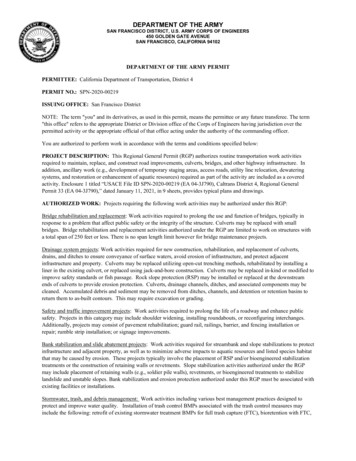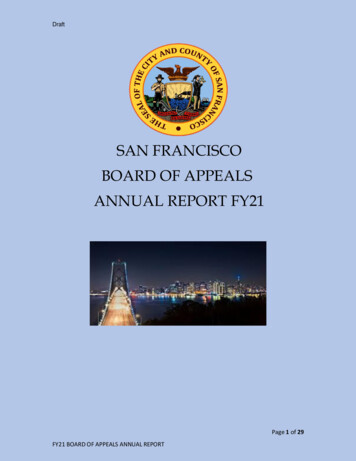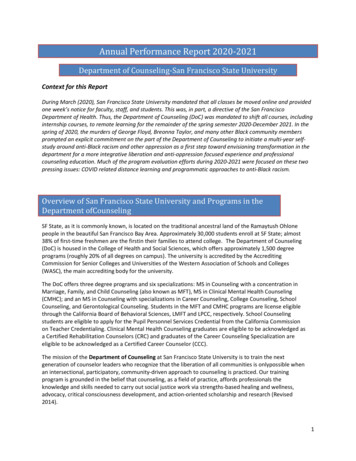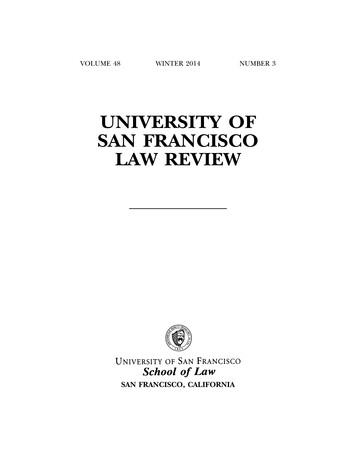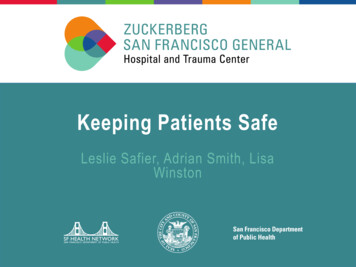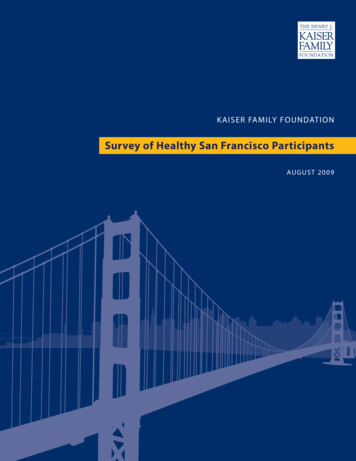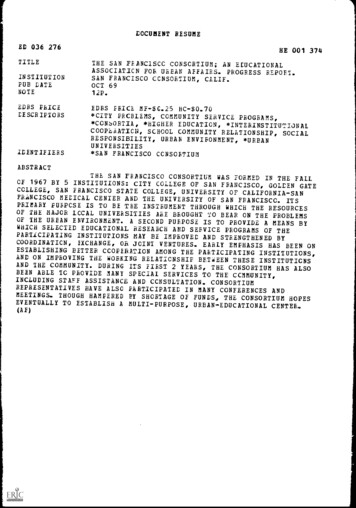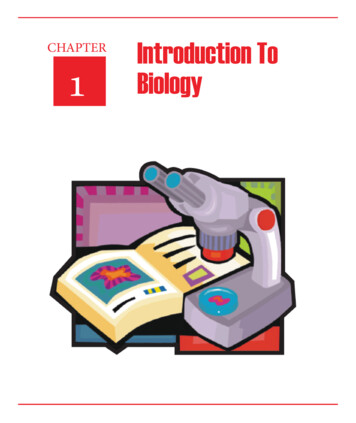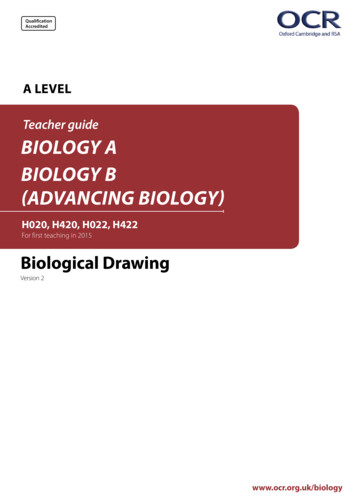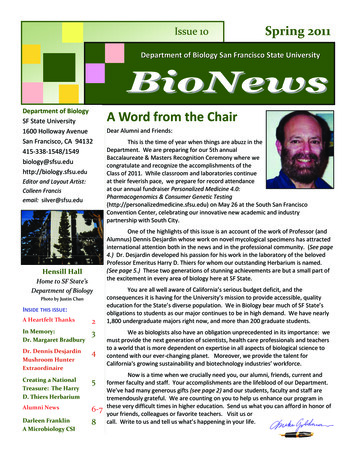
Transcription
Issue 10Spring 2011Department of Biology San Francisco State UniversityBioNewsDepartment of BiologySF State University1600 Holloway AvenueSan Francisco, CA iology.sfsu.eduEditor and Layout Artist:Colleen Francisemail: silver@sfsu.eduHensill HallHome to SF State’sDepartment of BiologyPhoto by Justin ChanINSIDE THIS ISSUE:A Heartfelt ThanksIn Memory:Dr. Margaret Bradbury23Dr. Dennis DesjardinMushroom HunterExtraordinaire4Creating a NationalTreasure: The HarryD. Thiers Herbarium5Alumni News6‐7Darleen FranklinA Microbiology CSI8A Word from the ChairDear Alumni and Friends:This is the time of year when things are abuzz in theDepartment. We are preparing for our 5th annualBaccalaureate & Masters Recognition Ceremony where wecongratulate and recognize the accomplishments of theClass of 2011. While classroom and laboratories continueat their feverish pace, we prepare for record attendanceat our annual fundraiser Personalized Medicine 4.0:Pharmacogenomics & Consumer Genetic Testing(http://personalizedmedicine.sfsu.edu) on May 26 at the South San FranciscoConvention Center, celebrating our innovative new academic and industrypartnership with South City.One of the highlights of this issue is an account of the work of Professor (andAlumnus) Dennis Desjardin whose work on novel mycological specimens has attractedinternational attention both in the news and in the professional community. (See page4.) Dr. Desjardin developed his passion for his work in the laboratory of the belovedProfessor Emeritus Harry D. Thiers for whom our outstanding Herbarium is named.(See page 5.) These two generations of stunning achievements are but a small part ofthe excitement in every area of biology here at SF State.You are all well aware of California’s serious budget deficit, and theconsequences it is having for the University's mission to provide accessible, qualityeducation for the State’s diverse population. We in Biology bear much of SF State’sobligations to students as our major continues to be in high demand. We have nearly1,800 undergraduate majors right now, and more than 200 graduate students.We as biologists also have an obligation unprecedented in its importance: wemust provide the next generation of scientists, health care professionals and teachersto a world that is more dependent on expertise in all aspects of biological science tocontend with our ever‐changing planet. Moreover, we provide the talent forCalifornia's growing sustainability and biotechnology industries’ workforce.Now is a time when we crucially need you, our alumni, friends, current andformer faculty and staff. Your accomplishments are the lifeblood of our Department.We’ve had many generous gifts (see page 2) and our students, faculty and staff aretremendously grateful. We are counting on you to help us enhance our program inthese very difficult times in higher education. Send us what you can afford in honor ofyour friends, colleagues or favorite teachers. Visit us orcall. Write to us and tell us what’s happening in your life.
ThankYouOur heartfelt thanks goesto the followingindividuals and businesseswhose generous giftsfunded inspiration,innovation, creativity,exploration, vision anddreams in 2010.forSupportingFidelity Charitable Gift FundMartha NoblesBarbara FranksPatricia OwenGenentech Foundationfor Biomedical ScienceDon PattersonLarissa GibbsKaren and Charles GillisonCharles GockelJackie HallEllen HamingsonSuzanne and Jeffery HarmonZheng‐Hui HeMahin Heidary‐CharlesAnonymous (13)Claudette and Raymond HernandezJanet AllenPatricia and Mark HerrickSergio and Ruby AragonLori HinesMary Aulbert‐VollandSylvia and Ronald HochedeDeb BakerSteven HoffmanNancy BegleyAndrew and Sasha HonigJennifer and David BollingerCarrie HunterBeth BoltzClinton and Mui JewMaria and James BoyerCharlene JosseRegina BritschgiSonia JuarezNeysa BudzinskiBenson and Shew JungMichael and Mary BurgettMargo Linden KatzAidan ButlerKeith KopischkeJohn and Catherine CampbellMischa KornievskyRobert and Ellen CaseRichard KouryDouglas CheathemRalph and Sandy LarsonXiaoying ChenPatricia LeeDeborah and John ColomboSusan LefeverAllison and Greg ConitzThomas and Roxanna LentonMarisue CrystalDavid LiuFlorence De LosadaEllen H. MacnealeSylvia de TrinidadDaniel and Barbara MaherJohn and Shirley DumontShalimar ManaliliJames DuncanCindy MansfieldJohn and Jean EllisonVictor MazzeoElizabeth and Neil EndeLeah and Kevin MeekFranklin EnnickMichelle Morse‐BuszardCarol EvkhanianCarol NakasoLaurie FahyThomas NiesenPage 2EducationRussell PittengerElaine PlaisanceJuergen PolstorffDr. Wenshen PongDr. Amy PortmoreDr. Ellen PragerConrad PriceElena C. RamirezRobert RamirezShirley RasmussenRoche Molecular Systems, Inc.Jenette and Jeremy ScottJohn and Julia SerencesPaul ShapiroTheresa and Kenneth ShielsEddie Simeon Jr.Jan Smith (in honor of Mia Mammen)Elizabeth StantonDr. John StevensDavid and Margaret SvobodaJames and Claribel SweeneyMichelle SwensonSherry SymingtonJoseph and Margaret TiegerHongyun TongMina TorabiNancy TowleShirley Van GardeHannah ViernesStephen VollandThomas and Rosemary Wakeman IIIChristopher WeideLisa D. WhiteLinda WhittlePotter WickwareDale Darlene WongMr. and Mrs. Douglas WongCoby Wright
IN MEMORYMargaret Bradbury1927‐2010Talented Artist, Dedicated Ichthyologist, Superb EducatorMargaret G. Bradbury, Professor Emerita, diedin Pacific Grove, California on October 9, 2010.Her Ph.D. dissertation focused on the batfish familyOgcocephalidae — a group she continued to study wellintoher retirement years. According to Dr. TheodoreDr. Bradbury began her scientific career as a StaffPietsch in a 1967 paper “The Genera of Batfishes” Dr.Artist in the Department of Zoology at the ChicagoBradbury “examined the group as a whole, preciselyNatural History Museum (now Field Museum) whileattending Roosevelt College. She received her B.A. in defining the limits of the family and each of the ninegenera (then recognized) providing a list of species forZoology in 1955.each genus and a phylogenetic analysis. In 1980, Dr.After graduation, she entered the doctoral programBradbury produced a detailed and beautifullyat Stanford University, and worked with Dr. Rolf Bolin illustrated revision of the new world batfish genusat Hopkins Marine Station in Pacific Grove. There,Ogcocephalus in which she recognized 12 species,Margaret formed lifelong friendships with many fellow describing five as new to science. Equally impressivestudents who later became leaders in marine biology. revisions of the allied genera Halieutopsis containingdescriptions of four newDr. Bradbury received herPh.D. in Biological Sciences “Margaret was a wonderful ichthyologist species and Dibranchus withdescriptions of a new genusin 1962, and joined SF State’swho marveled at the fishesand four new speciesDepartment of Biologyshe studied and admired.”appeared in 1988 and 1999,faculty in 1963. She taughtrespectively.In total, Dr.Ichthyology, Biology of- Dr. Gregor Caillet, MLMLBradburydescribed16 newFishes, Comparativespecies and one new genus.”Vertebrate Anatomy,History of Biology, and Evolution. “One of hernotable contributions came just before herretirement,” recalls Professor Emeritus Dr. RalphLarson, “when the Biology Department switched froma Zoology/Botany introductory sequence for majors toan integrated one‐year, two‐semester course. Sheserved on the committee that took charge ofdeveloping the second‐semester course which focusedon evolution, the diversity of life and ecology.”Dr Bradbury led many class trips along the Californiacoast from Big Sur to Mendocino. Former College ofScience and Engineering Dean Dr. James Kelleyremembers that she “never questioned the value offield research, in fact she was happiest when she wasdoing just that.”Dr. Bradbury was a Research Associate and Fellow ofthe California Academy of Sciences where she carriedout much of her research. She was both a member andserved as Chair of the Moss Landing MarineLaboratories (MLML) Governing Board, and after herretirement, the Board of the Friends of MLML.Dr. Bradbury retired from SF State in 1994, but herlegacy lives on through the many students whobenefitted from her guidance, support, encouragementand mentorship—and by her work in systematicswhich was exemplary, careful and precise, setting highstandards for others to follow.The Editor thanks Dr. Tomio Iwamoto, Curator andChair, Department of Ichthyology, California Academyof Science for his contribution to this article.To make a donation in memory of Dr. Bradbury, visit http://biology.sfsu.edu and click on the“Make a Difference” link. Please select “Biology Department” in the drop down list and write“In Memory of Dr. Margaret Bradbury” in the “Comments” box. Thank you.
DENNIS DESJARDINDennis Desjardin is the Indiana Jones of the fungaldiscovery world. He has research projects in WestAfrica (São Tome and Princípe), Brazil, Micronesia,Thailand, Indonesia, Malaysia, and the Hawaiian Islands.In Thailand, he helped established the MushroomResearch Centre which includes a laboratory, restaurant,visitors’ lodge, student chalets, and a mushroom‐shapedswimming pool. His planning for research expeditions caninvolve years of negotiating with foreign governments anduniversities, often promising host nations microscopes,computers, and other equipment, training local studentsand providing duplicate specimens of every fungus histeam removes from the countryside.Dr. Desjardin’sresearch focuseson discovering and documenting the diversity of fleshyfungi from under‐explored tropical habitatsworldwide. He wants to learn which species arepresent, their function in the ecosystem, who they arerelated to, how they got there, where they came from,and their uses by indigenous people.Dr. Desjardin has published 105 scientific papers in whichhe has described over 220 new species of mushrooms.In 2009, he discovered seven new glow‐in‐the‐darkmushroom species, including Mycena luxaeterna (eternallight) (see page 5) and Mycenaluxperpetua (perpetual light)“The natural roles of fungi are diverse—they increasing the number ofknown luminescent fungidecompose dead logs, form symbioticspecies from 64 to 71.Professor Desjardin learned howto identify a trio of edible fungispecies (champignons, porciniand chanterelles) at the agerelationships with plant roots to take up waterthree from his parents andSwiss grandparents whoThe secret to his success isand nutrients and repel disease.routinely gathered mushroomssimple: he is knowledgeableBut, much of their extraordinary powerswhen they lived in Switzerland.about mushrooms and he goesprobably are still unknown”An alumnus of SF State’sto places no other mycologistsDepartment of Biology, hehave been. In 1998, Dr.earned a BS in Biology in 1983,Desjardin was awarded the Alexopoulos Prize from theand a M.A. in Ecology and Systematic Biology in 1985.Mycological Society of America for outstanding researchHe received his Ph.D. in 1989 at the University ofand the Weston Award for outstanding teaching.Tennessee, and taught at Oberlin College before joiningthe Biology faculty in 1990. In addition to teaching and“Although edible and pharmaceutical mushrooms haveresearching mushrooms worldwide, he also finds the time become big business, the numbers of biologists whoto serve as Director and Curator of the Harry D. Thiersspecialize in fungi are becoming less and less,” said Dr.Herbarium (see page 5) collection of 140,000 preservedDesjardin who encourages the education and training ofspecimens of plants and fungi.young taxonomists around the world. To facilitate thisgoal, he is an Adjunct or Honorary Professor at fiveuniversities in Southeast Asia. Dr. Desjardin can becontactedat: ded@sfsu.eduPage 4
Marasmiustageticolor (left)Photo byD. Jean LodgeSpongiformathailandicaPhoto byD.E. DesjardinPhallus drewesii(right)Photo byBrian PerryTHE HARRY D. THIERS HERBARIUMLocated in Hensill Hall Room 429 is the Harry D. ThiersHerbarium. This facility houses over 40,000specimens with over 85,000 specimens of fleshy fungi —the largest and most important collection of fleshy fungiwest of the Mississippi.Photo by Justin ChanThe Herbarium began in the early 1960s with a fewherbarium cases in the office of Dr. Harry Thiers, amycologist who joined the San Francisco State CollegeBiology faculty in 1959. Dr. Thiers earned a B.A. fromSchreiner Institute (Texas) in 1941 and a M.A. from theUniversity of Texas at Austin (1947) where he was firstintroduced to mycology. After receiving his Ph.D. from the University of Michigan (1956), he moved to Californiawhere the knowledge of California’s agarics was poorly understood.Dr. Thiers’ research in California, North America, and trips abroad led to his publicationof over 150 new species of fungi, eight published books, and 50 papers in leadingscientific journals. He became recognized worldwide as the leading authority onboletes and as an innovator in secotioid fungi research. One of his greatest joys wastraining students, and he supervised 36 master’s degree theses — all of whichcontributed in some way to the documentation of the cryptogamic flora of California.He received numerous honors including the Mycological Society of America’sDistinguished Mycologist Award and the Fellows Medal from the California Academy ofSciences — its highest award and the first ever presented to a mycologist. He was alsohonored by fourteen different taxa named after him including the genus Thiersia.Dr. Thiers believed that properly named and preserved specimens for groups oforganisms that are poorly documented in the scientific literature are essentialreference tools for teaching and research. He was so dedicated to his collection thathe took type specimens home for protection during the 1960s student riots at SF State.First started as a few herbarium cases in a faculty office, the Harry D. Thiers Herbariumhas grown today to be one of California’s national treasures.Dr. Harry D. Thiers(1919-2000)To donate in memory of Dr. Thiers and/or in support of the Herbarium, please visit http://biology.sfsu.edu, and click on the“Make a Difference” link. Select “Biology Department” and please write “In Memory of Dr. Harry Thiers.” Thank you!Photos byCassius StevaniPage 5Mycena luxaeterna
ALUMNI NEWSAdvancingGlobal Health andthe Biosphere:Dr. Kristin Byrd (MA Ecology and Systematic Biology 1998)is a physical scientist with the U.S. Geological Survey working onthe Puget Sound Ecosystem Portfolio Model that evaluates howfuture urban growth may alter nearshore ecosystems.EducatingGenerations ofScientists,HealthProfessionals,Teachersand CitizensDr. Jaime Chaves (MA Ecology and Systematic Biology 2004)received his Ph.D. from the UC Los Angeles in 2010. He is aPostdoctoral Fellow at the Marjorie Barrick Museum of NaturalHistory (Nevada) and a Senior Research Fellow at UCLA’s Centerfor Tropical Research.Dr. Andrew Kangas (BA Biology 1969)received his Ph.D. and ND degrees in Naturopathy from Clayton College ofNatural Health in 2010, and owns a stem cell research lab in San Franciscowhere he is working on a cure for TB and malaria.Vanja Krneta‐Stankic (M.S. Cell and Molecular Biology 2010)is a PhD candidate in Developmental Biology in the lab ofnoble‐laureate Dr. Christiane Nüsslein‐Volhard at the MaxPlanck Institute, Germany.Dr. Joshua McDill (MA Ecology and Systematic Biology 2001)received his Ph.D. from the University of Texas in 2008, and isa post‐doctoral fellow at the University of Edmonton in Alberta.Erica Swinney (MA Ecology and Systematic Biology 2004)is the Director of Career & Community Programs at AustinPolytechnical Academy which prepares high school students foradvanced manufacturing careers. She also works withcommunity leaders to promote green economic development.Isidore Szczepaniak (MA Marine Biology 1990)is a Research Associate at the California Academy of Sciences’ Department ofMammalogy, a naturalist for the Oceanic Society, and Co‐Principal Investigatorof the Golden Gate Cetacean Research Group.MICHELINE CAPRIOBIOLOGY’S OLDEST LIVING ALUMNA?Alicia Leon Jhong (BS Clinical Science 1981) wrote to us about herclassmate 88 year old Micheline Caprio (BS Clinical Science) ofWalnut Creek, California. Micheline was in her 50’s when sheattended SF State, and especially enjoyed her classes with Drs.William Wu, Bernie Goldstein and Remo Morelli though herfavorite class was “Medical Illustration.” What she enjoyed bestin her biology classes was the opportunity to use the microscope.Originally from France, Micheline worked as a midwife in Paris. After graduating from SFState, she worked in hospital and pharmaceutical laboratories. According to Alicia,Micheline’s house is adorned with the many paintings she has done of her native village.“She likes to transform whatever beauty she finds in nature into art.”A Biology Alum?Email silver@sfsu.edu and share your achievements.
KAREN ALROY—Veterinary Health ResearcherKaren Alroy is a former tech and postbac who worked in Dr. Sarah Cohen’s labwhile attending classes to complete vet school requirements. Karen wrote to usfrom Peru where she is conducting infectious disease research.“While I am only one of a few veterinary students in the National Institutes of HealthFogarty Scholars Program, I have found a wonderful community of vets here in Peruwho work closely with public health. I am also fortunate to have a fantastic mentor,Dr. Bob Gilman, who is a world renowned global health infectious disease researcher,and a faculty member at the Bloomberg School of Public Health at Johns Hopkins.I work on two projects here in Peru. The first one is a epidemiological study ofChagas disease in several remote communities in the Cajamarca region of NorthernPeru. During a month‐long field trip last fall, I led a team of biologists to take bloodsamples from guinea pigs and dogs. We also collected Triatomines (or Chirimachasas they are called here), the vector of the parasite that causes Chagas disease. Mysecond project is based in Lima where I am working closely with veterinarians from the San Marcos School of VeterinaryMedicine developing a minimally invasive experimental model for neurocysticercosis in pigs. Neurocysticercosis isanother parasitic disease, and the leading cause of seizures in people in the developing world.”‐ Karen Alroy (Karen.Alroy@tufts.edu)p.s. During my time in Peru I have also had the opportunity to learn Spanish, hike in the Andes, and even race ahandmade raft 120 miles down the Rio Amazonas. It has been an incredible experience!”THANKS FOR THE MEMORIES .We asked alumni to write in and share their memories of their time at SF State.Alumni, UC Berkeley gardener and founding member and volunteer archivist forCalifornia's Green Party, Hank Chapot, (photo left) wrote to tell us about his experience.“In 1972, I entered SF State as an art student with a fascination for natural history, andtook a class called “Nature Study” from Dr. J. Russell Gable, an old‐school naturalist withan office filled with mounted specimens and a live baby rattler. I changed my major, andcommitted myself to field trips starting with Gable’s desert biology. I studied underDr. Bob Sweeney (taxonomy and fire science), Dr. George Batchelder (Pleistocenebiology), Dr. G. Ledyard Stebbins (plant population research), Dr. Elizabeth McClintock(trees) and Dr. Jeannie Davis (ecological physiology). In 1976, I participated in aNSF‐funded study: A Biological Baseline Study of the Sierra Valley Marsh—California.We stayed at University‐owned Camp Leonard above Sierra City from June‐August.Steel Bridge, Study Site 3, Sierra ValleyHaving received proper permits, we picked up road kill and collected a few bats to makestudy skins for the on‐site camp collection. Participants included Director, Patricia Bushnell, who along with AnthonyJames studied birds and mammals, Sally Blaisdell (amphibians and reptiles), Candice Cooperrider and An Susterich(ichthyology), Kathleen Groneck and twins Fred and Greg Sommers (botany), Frances Cave and Kate Richardson(arthropods) and myself (water analysis, maps and weather). Jim Hawkins’ participation was also important to thestudy. In the fall we took a class with Dr. James Mackey to complete the write‐up. During Christmas 1976, Patty,David, Kate and I travelled to the NSF report‐ back in Washington, D.C. where we met other students who hadcompleted NSF studies.” ‐ Hank Chapot (B.A. Ecology and Systematic Biology 1977), email: hchapot@igc.orgPage 7
Nonprofit OrganizationUS Postage PAIDSan Francisco, CADepartment ofof BiologyBiologyDepartmentSan FranciscoFrancisco StateState UniversityUniversitySan1600 Holloway Avenue1600 Holloway AvenueSan Francisco, CA 94132 -1740Permit #7741The Department of Biologyproudly presents:Personalized Medicine 4.0:Pharmacogenomics andConsumer Genetic TestingMay 26, 2011For more information,visit: http://personalizedmedicine.sfsu.eduBiology Staff is a Microbiology CSI!Biology Instructional Services Facility Supervisor Darleen Franklin analyzed thecontent of a random BART seat for a New York Times article “On BART Trains,the Seats are Taken (by Bacteria)” — and her results may make BART riderswant to stand during their next trip!In two separate tests, Darleen identified characteristics of the MRSA bacteria(known as the “superbug” because of its resistance to antibiotics) in a swabtaken from the seat cushion and headrest of a seat on a train headed from DalyCity to Dublin/Pleasanton. The first test confirmed the presence ofstaphylococcus aureus, a skin‐borne bacteria; a second test confirmed that thebacteria was resistant to the antibiotics methicillin and penicillin. A third testthat confirms for MRSA strain came back negative. Even after Darleen cleanedthe cloth cushion with an alcohol wipe potentially harmful bacteria were foundgrowing in the fabric. A BART spokesman wrote that the findings were “notsurprising,” considering that 330,000 commuters rode the trains daily, and that hygiene has emerged as a key issue asBART officials determine what kind of seats to install for a new fleet of cars in 2017. Darleen also tested random MUNIacrylic plastic seats on a No. 8 (San Francisco to Daly City) bus, and found two benign bacterial colonies. Unlike theBART seat analysis, after she cleaned the MUNI seat with an alcohol wipe no bacteria were detected.“We have created an environment for bacteria to grow and become less resistant to drugs.”A year after Darleen joined the Biology Department in 2005, she was asked by SF State’s [X]press newspaper todiscover what types of bacteria and fungi lived in the University Gym. She swabbed the shower floor in the women’slocker room, a barbell from the weight room, a bathroom door handle in the men’s locker room, and a workout mat,and found mold, a fungus, Micrococcus (a common bacteria found on human skin and in water, dust and soil) andStaphylococcus (another common bacteria that lives harmlessly on skin especially in the crevices and in the nose.).
Tennessee, and taught at Oberlin College before joining the Biology faculty in 1990. In addition to teaching and researching mushrooms worldwide, he also finds the time to serve as Director and Curator of the Harry D. Thiers Herbarium (see page 5) collection of 140,000 preserved
